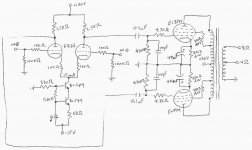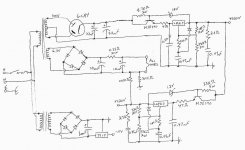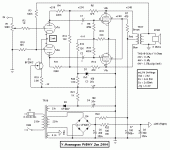Well, after many changes to what I originally started to build, I think I have made up my mind on what to build. It's mostly straight out of Morgan Jones' book, the output stage from the Bevois Valley amp, the transistor CCS, and his simplified of the Maida regulator. I was hoping someone would be so kind as to briefly review for errors, sanity check, and simple enhancements I missed.
Attachments
Hi leadbelly,
I would run the B+ for the output stage straight from the filter, not regulated. I haven't checked, but if this is stereo, will a 6CA4 supply enough current?
A simple zener diode or string would be fine to run the voltage amp stage with. Or a simple two transistor regulator (error amp and pass).
-Chris
I would run the B+ for the output stage straight from the filter, not regulated. I haven't checked, but if this is stereo, will a 6CA4 supply enough current?
A simple zener diode or string would be fine to run the voltage amp stage with. Or a simple two transistor regulator (error amp and pass).
-Chris
Hello Leadbelly,
that's very similar of what I have in mind for my next amp, only that it won't be UL but straight triode.
Why are you using 6922 input tube (thus necessing big voltage drop to power it - from 320 to 120V)? Won't a 12A*7 work there?
Like this (intended for the triode section of ECL86, similar to 12AX7 or, better, 5751):
that's very similar of what I have in mind for my next amp, only that it won't be UL but straight triode.
Why are you using 6922 input tube (thus necessing big voltage drop to power it - from 320 to 120V)? Won't a 12A*7 work there?
Like this (intended for the triode section of ECL86, similar to 12AX7 or, better, 5751):
Attachments
anatech said:I would run the B+ for the output stage straight from the filter, not regulated.
Well PSUD2 tells me there is 20V of ripple at that point; surely that would be audible?
anatech said:I haven't checked, but if this is stereo, will a 6CA4 supply enough current?
It's rated for 150mA.
Giaime said:Why are you using 6922 input tube (thus necessing big voltage drop to power it - from 320 to 120V)? Won't a 12A*7 work there?
I read a lot of good things about ECC88 and 6922, so I bought a bunch of them. I generally read bad things about 12AX7
Danko said:But, why need that CCS (in the first post) 2 transistors? One transistor isn't enough?
The 2 transistor version is higher performance. In Jones' book, he puts the single BC549 CCS at 92 kohms and the double BC549 CCS at 32 Mohms.
Hi leadbelly,
Your ripple (p-p value?) will be cancelled by the push pull stage. Look at the older amps built in the 50's and 60's.
As for the 6CA4, I like a little more headroom. A 5AR4 comes to mind.
The 12AX7 was designed for voltage amplification. It has a high plate resistance, but performs well when used correctly. Most new designers don't seem to have a clue on that one. The trick is to keep high frequency losses down (thanks to Miller). I do have amplifiers that use the 12AX7 and they sound great. You can use a 6922 or 6DJ8 also, your choice. They are a totally different animal.
SY and others can comment more on that topic.
-Chris
Your ripple (p-p value?) will be cancelled by the push pull stage. Look at the older amps built in the 50's and 60's.
As for the 6CA4, I like a little more headroom. A 5AR4 comes to mind.
The 12AX7 was designed for voltage amplification. It has a high plate resistance, but performs well when used correctly. Most new designers don't seem to have a clue on that one. The trick is to keep high frequency losses down (thanks to Miller). I do have amplifiers that use the 12AX7 and they sound great. You can use a 6922 or 6DJ8 also, your choice. They are a totally different animal.
SY and others can comment more on that topic.
-Chris
1.5K plate load resistors are a problem. Why did you choose such a low value? You'd want something more like 20K. 6DJ8 is a reasonable input tube choice.
Cathode CCS is a good idea. I haven't checked your values yet.
With properly loaded anodes, a 6DJ8 diff amp should give you a gain of 12 or so on each side. You need 8V to drive the EL84 to clipping, so with a standard 2V input, you've got room for feedback to work.
Cathode CCS is a good idea. I haven't checked your values yet.
With properly loaded anodes, a 6DJ8 diff amp should give you a gain of 12 or so on each side. You need 8V to drive the EL84 to clipping, so with a standard 2V input, you've got room for feedback to work.
SY said:1.5K plate load resistors are a problem. Why did you choose such a low value? You'd want something more like 20K.
Maybe a typo?
 I think it should be 15k.
I think it should be 15k.SY said:1.5K plate load resistors are a problem. Why did you choose such a low value?
The input stage is basically this:
http://home.c2i.net/semfielec/tubepre.htm
except using single triodes. I have built that one with paralled triodes and like it fine.
SY said:With properly loaded anodes, a 6DJ8 diff amp should give you a gain of 12 or so on each side. You need 8V to drive the EL84 to clipping, so with a standard 2V input, you've got room for feedback to work.
I am trying to avoid using global negative feedback, hence the 330 ohm resistors on the UL taps as a starting point. Can I decrease the gain of the input stage to help stability?
this is a very interesting thread, also for me. I am at the point of building a PP with EL84 driven with an ECC88 diff.pair. I thought using this design
http://www.wdehaan.demon.nl/tubeamps/el84dc/index.html
I would make the CCS like the one from Morgan Jones and AC couple both stages.
Erik
http://www.wdehaan.demon.nl/tubeamps/el84dc/index.html
I would make the CCS like the one from Morgan Jones and AC couple both stages.
Erik
lb, you're not asking that preamp to swing more than a volt or two. And without feedback, the nonlinearity from the low plate load will be significant. Use a sensible value.
If you don't want to use a feedback loop, forget the 6DJ8. Use something with less gain like a 6SN7 or in 9 pin format, 6CG7/6FQ7. If you're really adventurous, you could even use 12B4s.
If you don't want to use a feedback loop, forget the 6DJ8. Use something with less gain like a 6SN7 or in 9 pin format, 6CG7/6FQ7. If you're really adventurous, you could even use 12B4s.
SY said:If you don't want to use a feedback loop, forget the 6DJ8. Use something with less gain like a 6SN7 or in 9 pin format, 6CG7/6FQ7. If you're really adventurous, you could even use 12B4s.
Yes, I am quite serious about not using a feedback loop. The only tubes that I already have on hand that are lower gain than the 6922's are some 6N6P's, mu=22. As I have never seen them used in a diff pair I will have to figure that out
Hi Giaime,
The proper application of feedback always seems to make things better. You can apply too much, or have a bad circuit design. That is no reason to lay blame to the concept of feedback.
Now, once you take the circuit out of it's linear range (clipping for example), feedback will then work to make the situation worse as it attempts to correct, but can't. The reason is that as soon as one circuit element becomes cut off, or saturated, the feedback loop is broken and the circuit then operates at open loop gain.
That would be my humble opinion. I am sure others may have different viewpoints.
-Chris
The proper application of feedback always seems to make things better. You can apply too much, or have a bad circuit design. That is no reason to lay blame to the concept of feedback.
Now, once you take the circuit out of it's linear range (clipping for example), feedback will then work to make the situation worse as it attempts to correct, but can't. The reason is that as soon as one circuit element becomes cut off, or saturated, the feedback loop is broken and the circuit then operates at open loop gain.
That would be my humble opinion. I am sure others may have different viewpoints.
-Chris
- Status
- This old topic is closed. If you want to reopen this topic, contact a moderator using the "Report Post" button.
- Home
- Amplifiers
- Tubes / Valves
- Is this EL84M UL PP OK?



 There are countless threads debating NFB
There are countless threads debating NFB